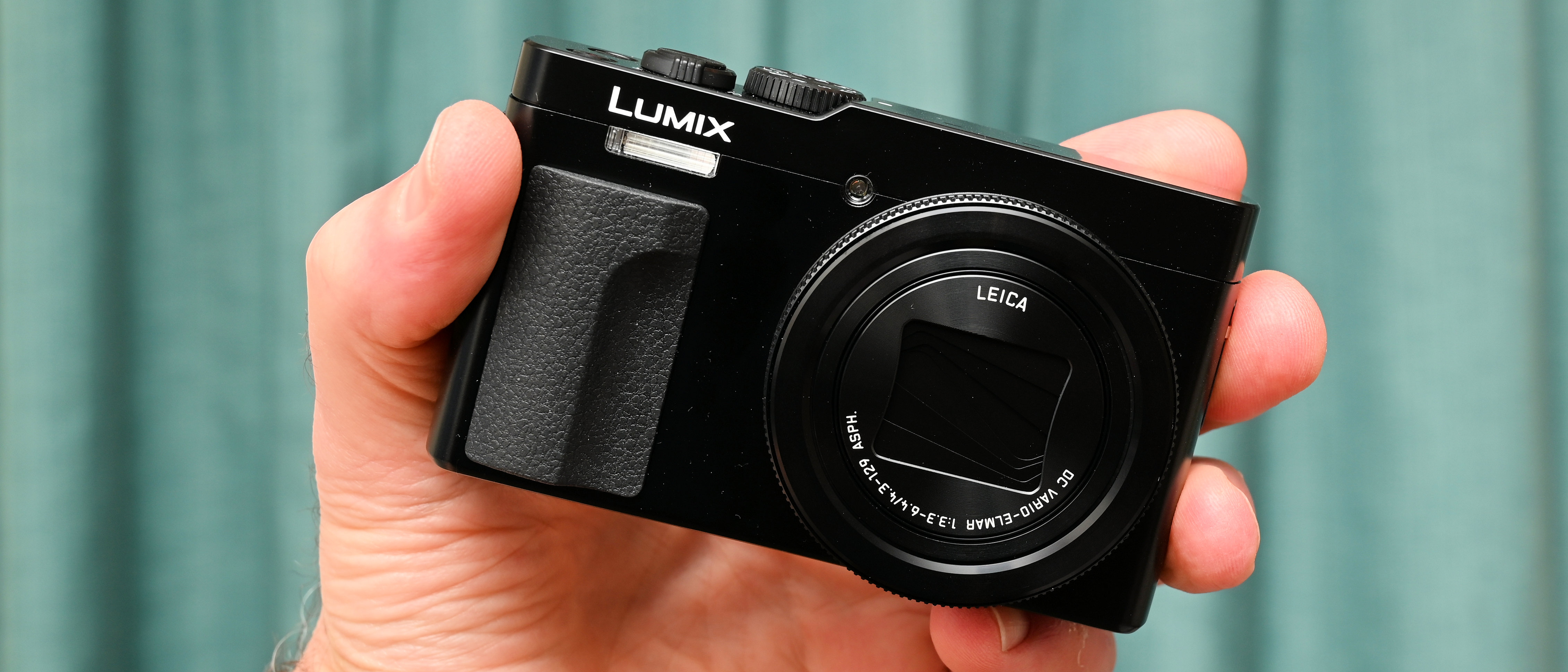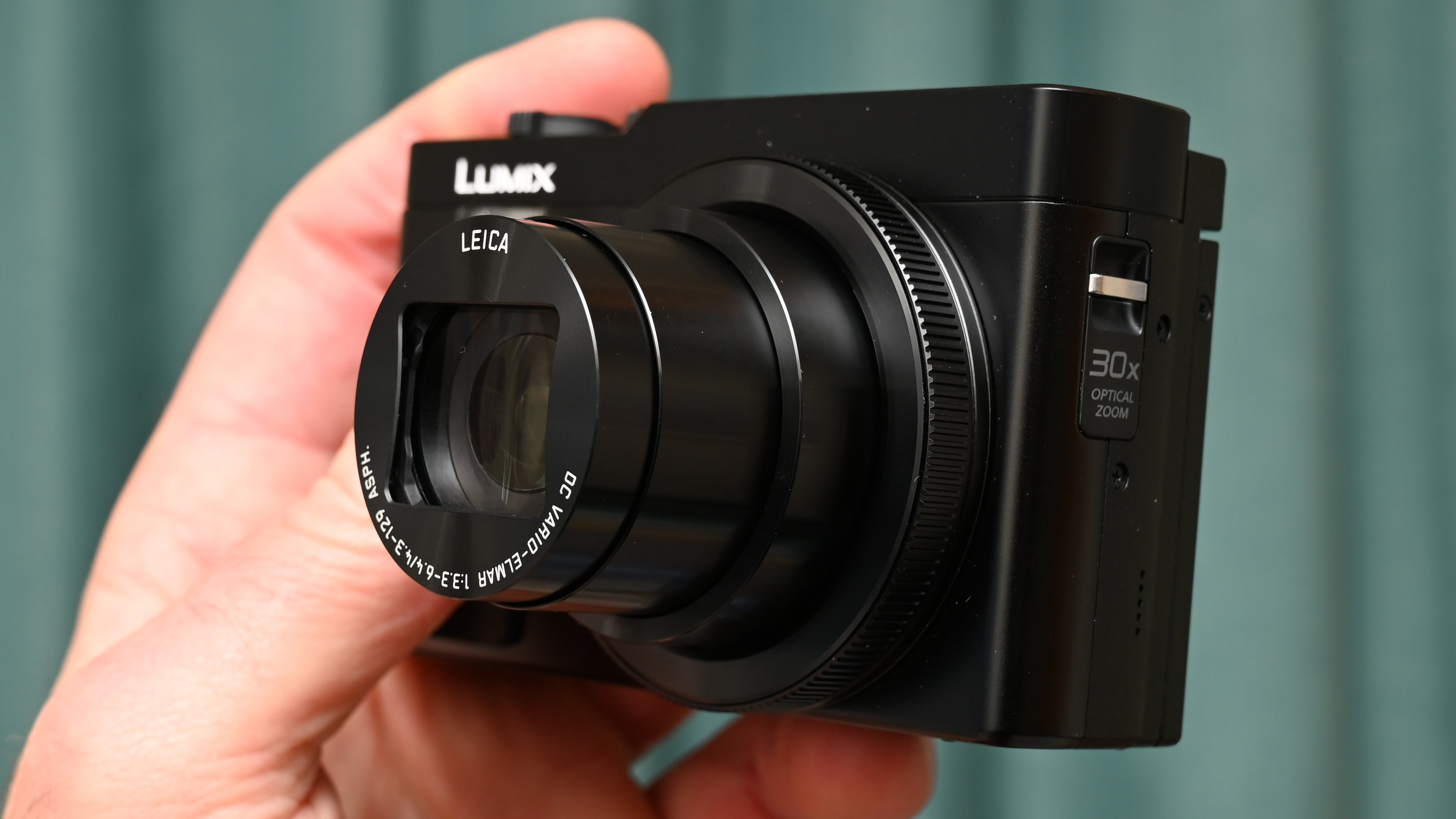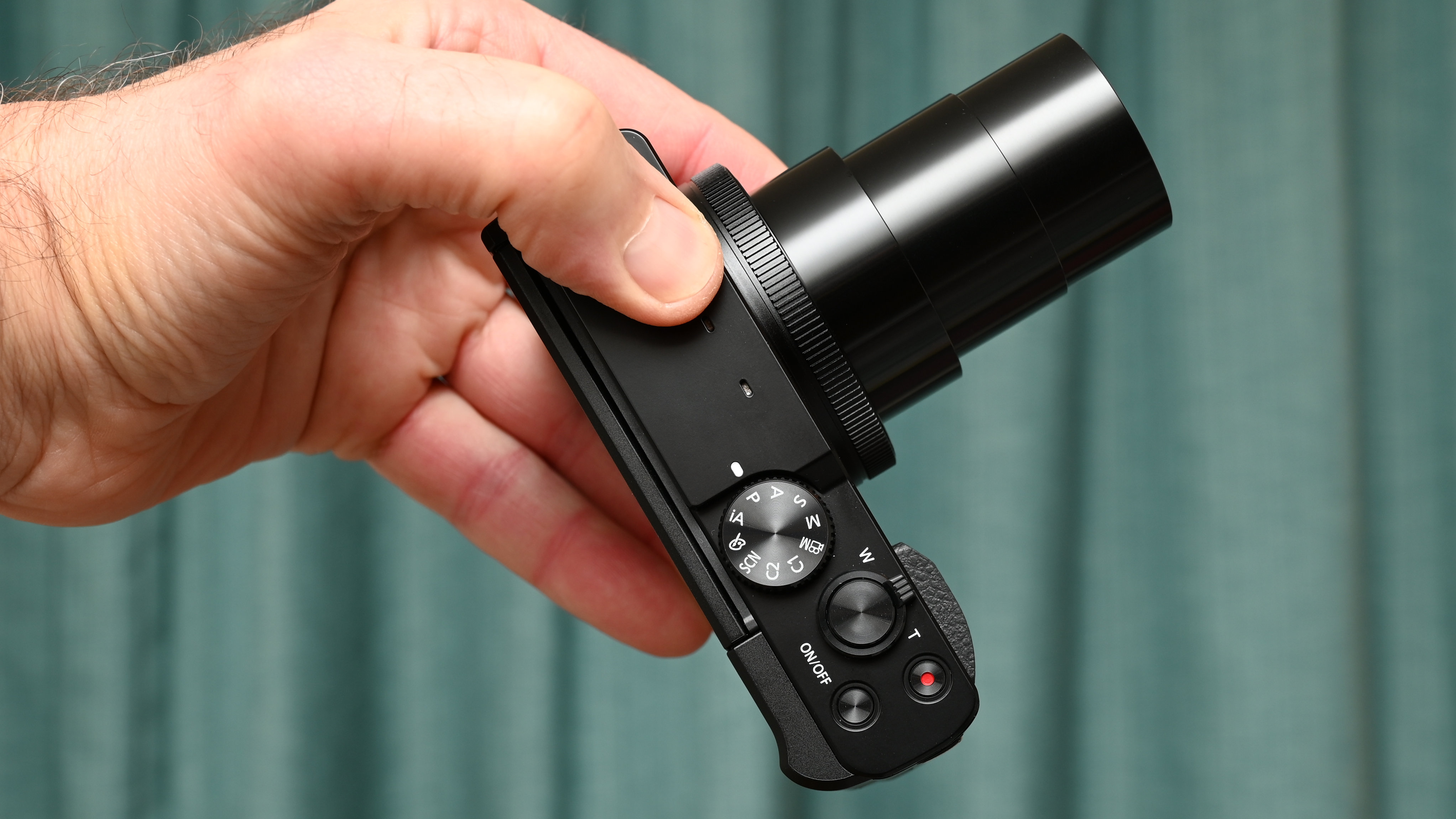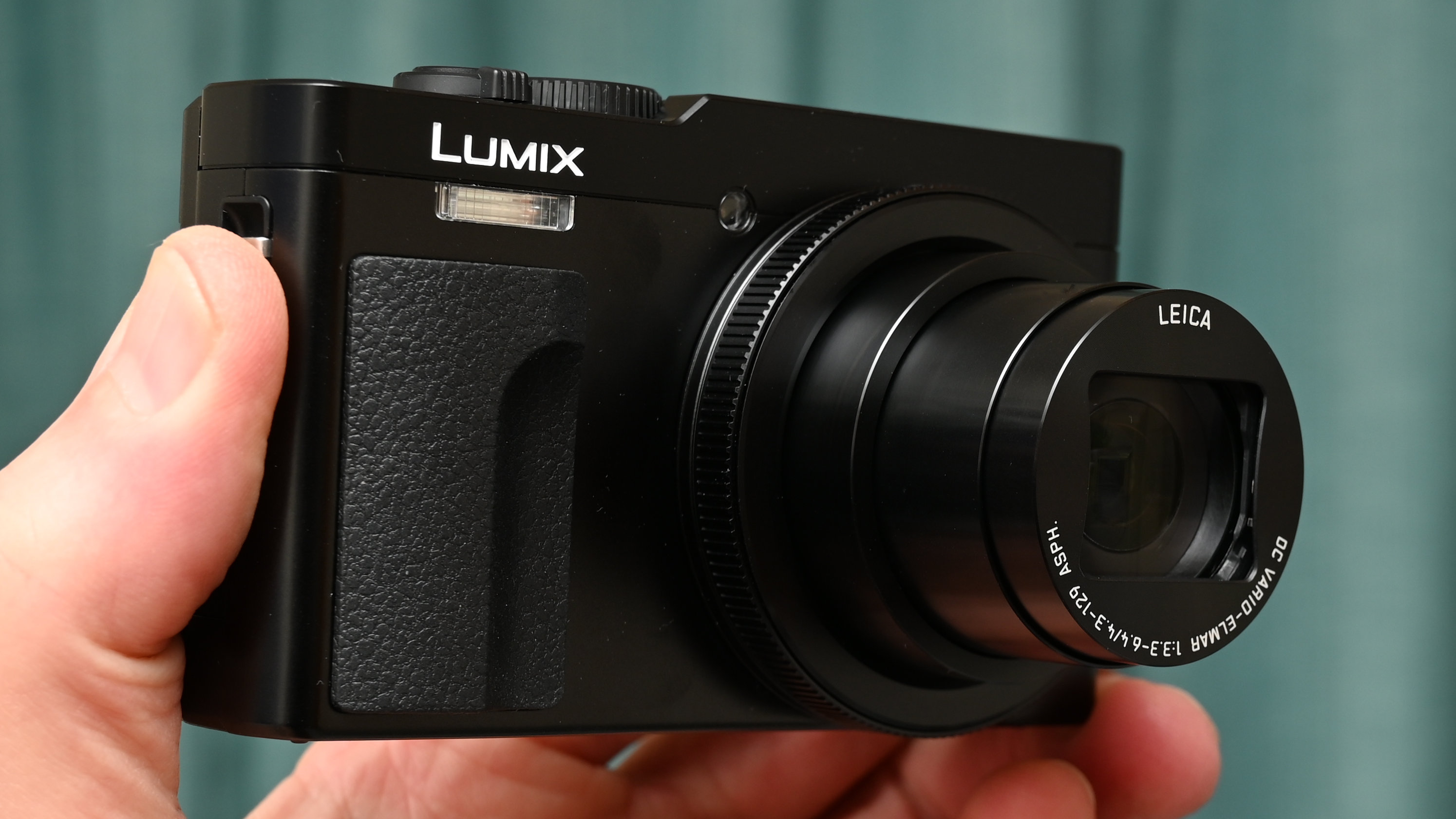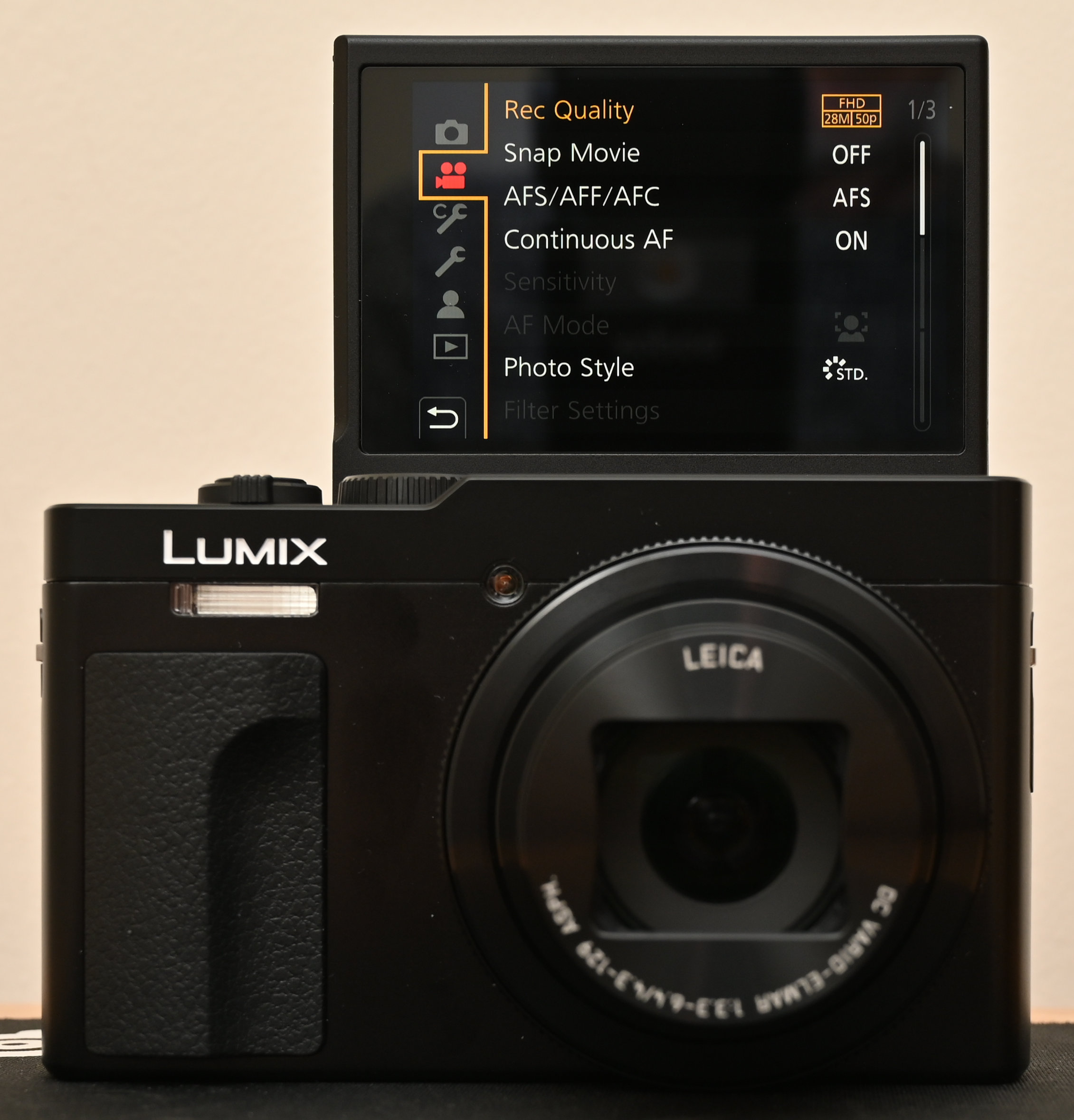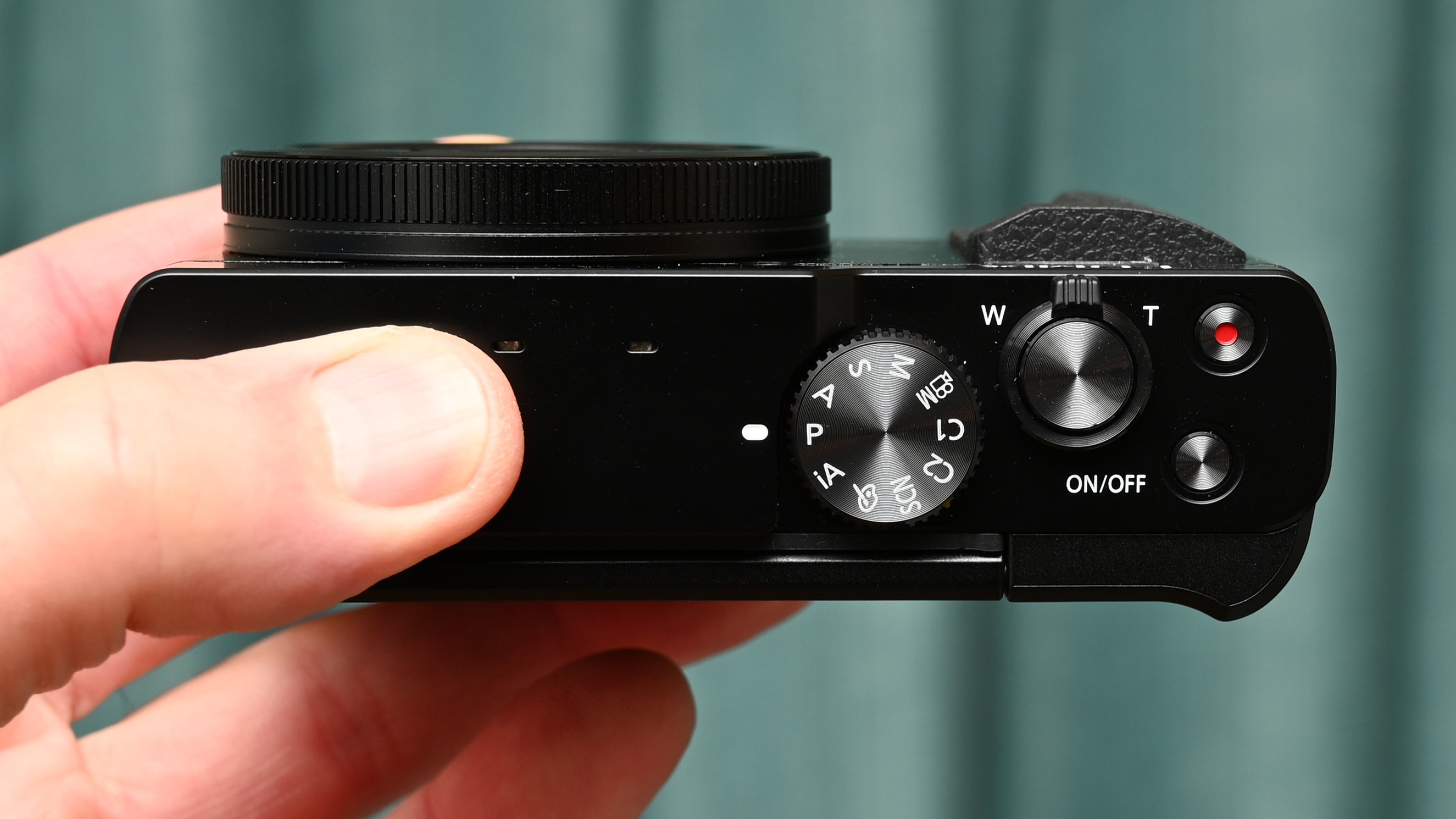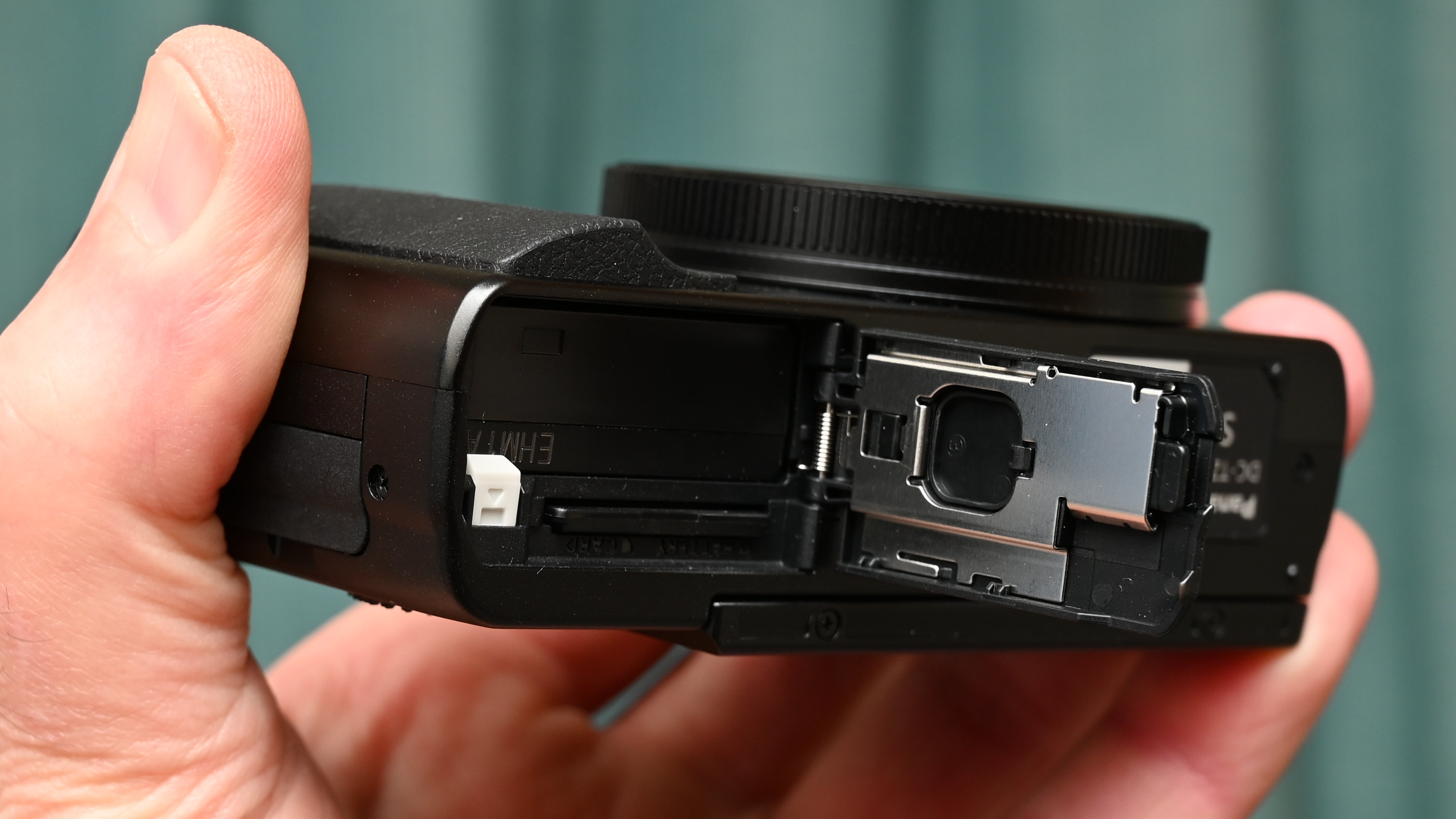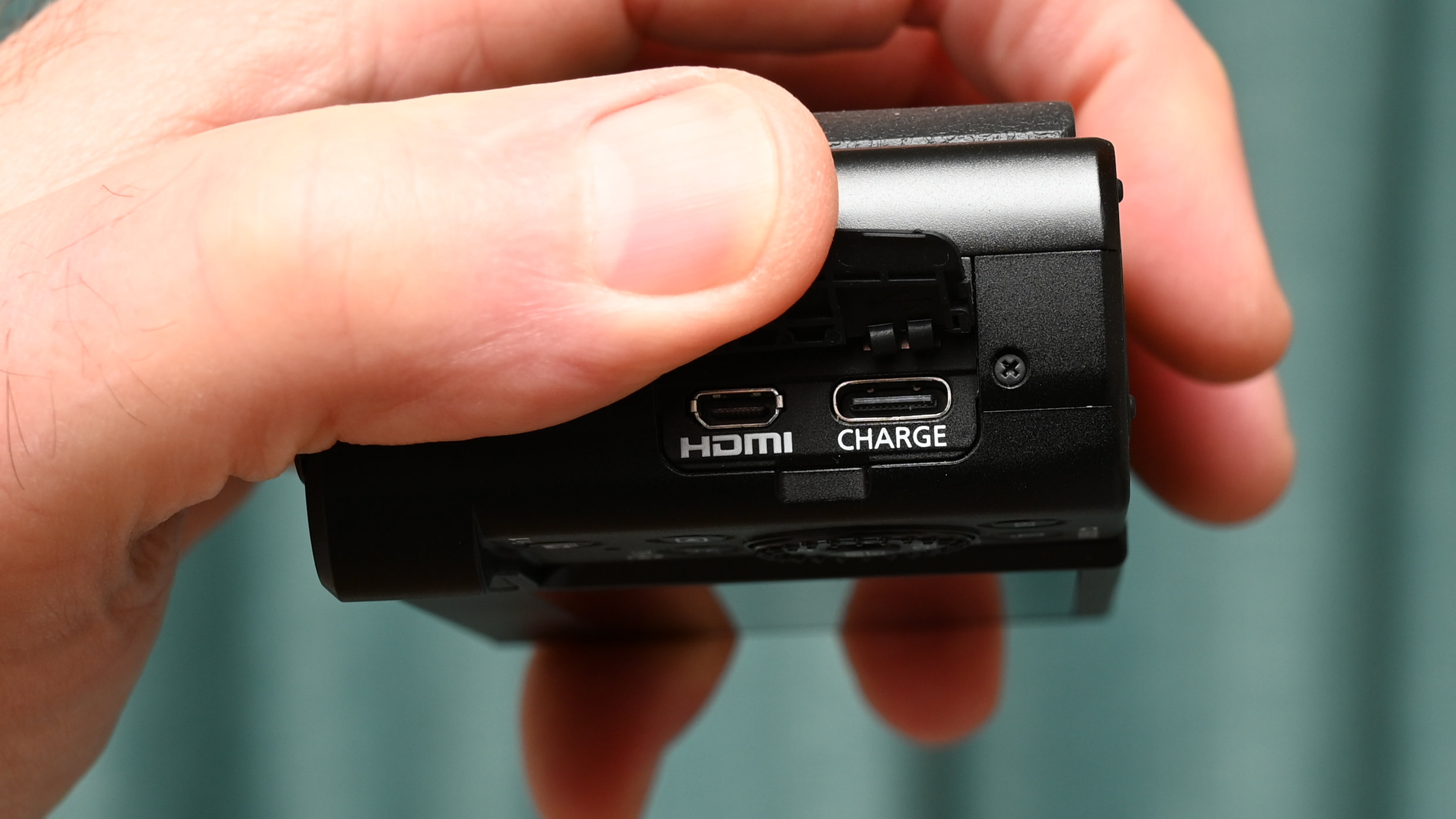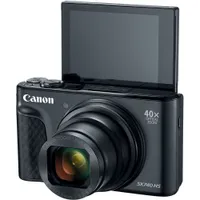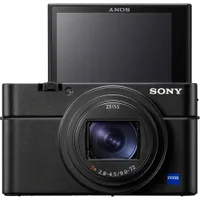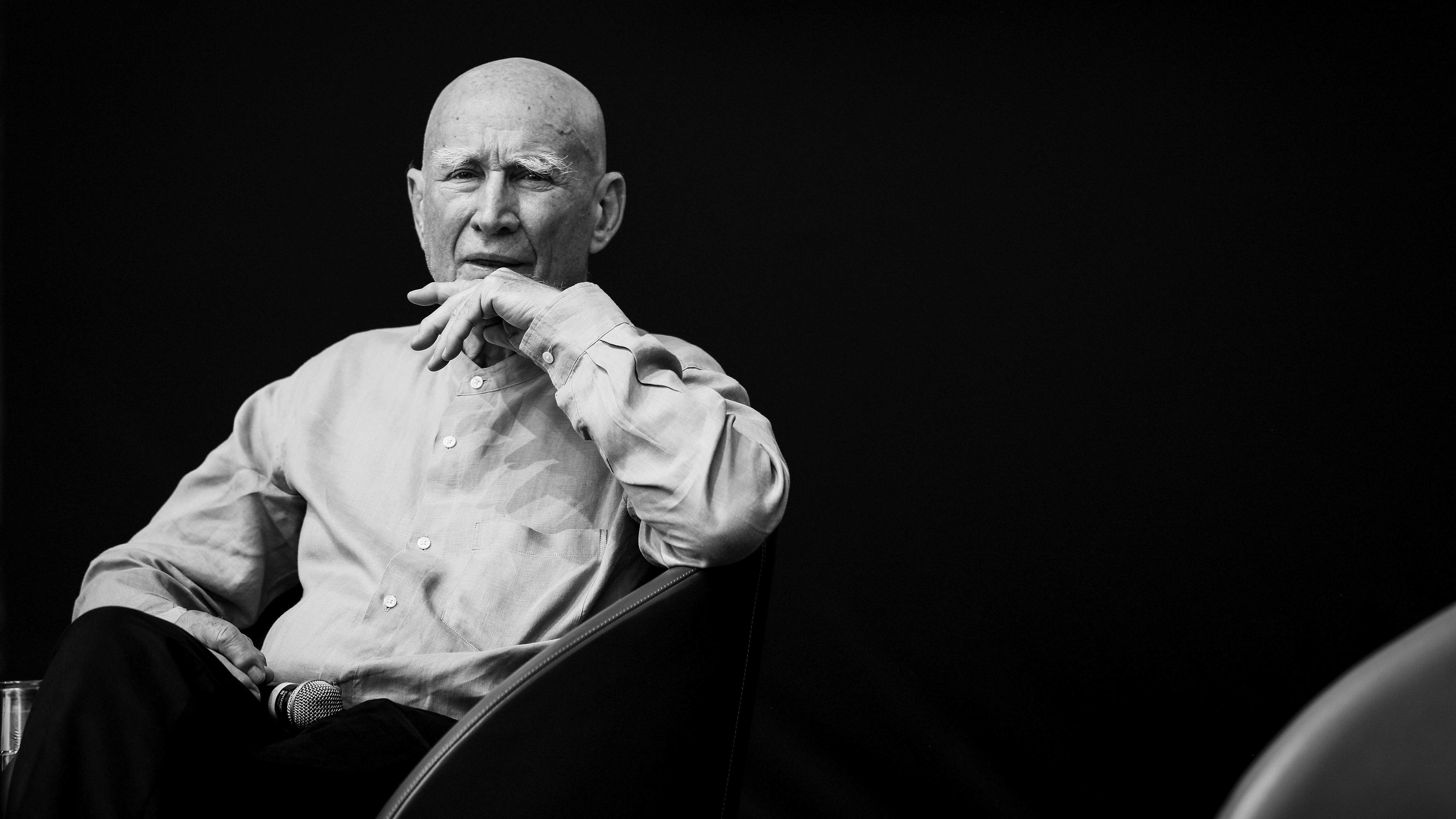Digital Camera World Verdict
I like that the Panasonic Lumix TZ99 (ZS99 in the USA) is small enough to fit in a coat pocket, yet boasts a huge 30x optical zoom range. It’s wonderfully travel-friendly and very nicely turned out, making it a small object of desire. But speaking of small, the tiny image sensor is a bottleneck in terms of picture quality.
Pros
- +
Monster zoom range
- +
Pocket-sized build
- +
Flip-over rear screen
Cons
- -
Small 1/2.3-inch sensor
- -
No viewfinder
- -
Variable image quality
Why you can trust Digital Camera World
I’m deadly serious about my photography. So when top-quality image capture is the order of the day, you’re likely to see me out and about with an interchangeable lens camera and a supporting cast of award-winning lenses. But that doesn’t mean I’m averse to a bit of fun, and a flashy camera kit isn’t always the best fit. Fun times like family holidays, days out by the seaside, and jet-away mini-breaks set a different agenda.
Going back a few years for these sorts of situations, when I wanted a camera I could slip into a spare pocket, the Panasonic Lumix TZ100 was my weapon of choice. Nearly a decade ago, I felt it was one of the best travel cameras that money could buy. The combination of a relatively large 1-inch image sensor, 10x optical zoom range (25-250mm equivalent), and electronic viewfinder was a winning combination in my mind.
Fast-forward to right here and now, and the new TZ99 has a similar look and feel, along with a pocket-friendly form factor. It’s fighting back against the dominance of mobile phones for casual, point-and-shoot photography. However, compared with my trusty TZ100, it cuts a few corners along the way, with a much smaller image sensor and no viewfinder. It’s actually a fairly minor revamp of the Lumix TZ95 / ZS80, and features the same image sensor and bumped-up 30x optical zoom range (24-720mm equivalent), but without its predecessor’s viewfinder. Let’s see how it all shakes out in the wash, and how the new model stacks up against some of the best point and shoot cameras.
Panasonic Lumix TZ99 / ZS99: Specifications
Sensor | 20.3MP 1/2.3-inch MOS |
Lens mount | 30x zoom 24-720mm (equivalent) f/3.3-6.4 |
Screen | 3.0-inch 1,840k dots, tilt, touch |
Viewfinder | None |
Image stabilization | 5-axis Hybrid O.I.S. (except for 4K video) |
Memory | SD/HC/XC UHS-I |
Shutter speed | 1/2,000 to 4 sec (mechanical) 1/16,000 to 1 sec (electronic) |
Max shooting speed | 10fps (AF-S) 5fps (AF-C, Live View) |
Exposure range | Unspecified |
ISO | ISO 80-6400 |
Autofocus | 49-area, 1-area, pinpoint, full area touch |
Video | 4K 30p, 1080 60p |
Connectivity | USB-C, microHDMI typeD, Wi-Fi, Bluetooth |
Battery | DMW-BLG10E, 280 shots |
Dimensions | 112.0 x 67.8 x 43.1 mm (4.41 x 2.67 x 1.70 inch) |
Weight | 332g (0.71 lb) with battery and card |
Panasonic Lumix TZ99 / ZS99: Price
The Panasonic Lumix TZ99 / SZ99 launched in early 2025 with a price tag of $498 / £469. That’s a fairly similar price point to the Canon PowerShot SX740 HS, another particularly travel-friendly camera with a 20.3MP 1/2.3-inch image sensor and an even bigger 40x optical zoom range, although the Canon lacks a touchscreen, and is priced at $480 / £430. I feel it’s a fair price to pay, especially if you want the longer telephoto reach of this type of camera, compared with taking photos and video on your mobile phone, which will be relatively lacking in telephoto reach.
Panasonic Lumix TZ99 / ZS99: Design & Handling
It’s no surprise that compact cameras have been steadily losing ground to smartphones over the last few years. After all, who needs a pocketable camera when you’ve already got a more slimline phone in your pocket, that can take good-quality photos and video? But while the best camera phones definitely deliver impressive performance, a big zoom range is something they still lack. That’s where cameras like the Panasonic TZ99 / SZ99 still have something to offer. The lens built into this camera has a relatively huge 30x optical zoom range, equating to 24-720mm in full-frame terms, and stretching from fairly generous wide-angle coverage to mighty super-telephoto reach.
One of the things that enables such a big zoom range in a pocket-sized camera is the use of a relatively small 1/2.3-inch image sensor. There’s nothing new about this. In fact, the brand spanking new TZ99 / SZ99 has the same 20.3 megapixel image sensor and zoom lens as the preceding TZ95 / ZS80 launched in 2019, which in turn had the same sensor and lens as the earlier 2017 TZ90 / ZS70. So what’s new? Well, the interim 2019 camera boasted a higher-resolution electronic viewfinder which, while physically small, had a very detailed 2.3 million dot display. In what might be seen as a retrograde step, the TZ99 / ZS99 ditches the viewfinder altogether, so the rear screen is the only option for composing images. You could argue that the latest model is purely intended to be a viable alternative to a mobile phone, with a huge zoom range. And when’s the last time you saw a viewfinder on a mobile phone?
The overall design is pretty slick. While the viewfinder of the previous cameras in the series didn’t protrude very much at all, the TZ99 / SZ99 is particularly sleek. Again, the zoom lens retracts completely when the camera is switched off, keeping the thickness down to a very pocketable 43.1mm or 1.7 inches. There’s a small flash module on the front panel which is also recessed within the sturdy-feeling casing. And despite being a very boxy shape, there’s a nod to ergonomics with a slightly sculpted, rubberized hand grip.
The best camera deals, reviews, product advice, and unmissable photography news, direct to your inbox!
Catering to the selfie/vlogging generation, the camera features a tilting flip-over 3-inch touchscreen with a healthy resolution of 1.84 million dots. You can therefore view the screen from in front of the camera. The screen takes up most of the back panel of the camera but there’s still room for an array of control buttons and dials, which are clearly labelled and easy to access.
Up on top, there’s a handy shooting mode dial and a rocker switch for adjusting the motorized zoom of the lens. On top of that, there’s the main shutter release button which has the usual half-press facility for initiating autofocus and metering. There’s also a video start/stop button to the right and an on/off button to the rear. The shooting mode dial covers all the bases with iA (intelligent Auto), PASM, scene modes, picture modes and two customizable settings. There are plenty of scene modes and creative picture controls to choose from. The use of aperture-priority mode is rather more limiting, as the zoom lens only enables an aperture range of f/3.3 to f/8 at the short end of its zoom range, and f/6.4 to f/8 at the long end, the latter being just two-thirds of an f/stop.
Autofocus is based on 49 areas across the image sensor and includes face/eye detection and tracking. As I’ve seen in a number of Panasonic cameras, this one features a 4K PHOTO shooting mode, which captures 8MP stills at a rate of 30fps. This can help to nail definitive moments, and it also enables options for post focus (where you can choose the ideal point of focus from a sequence of focus-shifted images) after the event, as well as focus stacking. In more regular shooting modes, you can shoot at up to 2fps with live view, or 10fps with manual or single autofocus mode and no live view between frames.
The only really new feature of the TZ99 / SZ99 compared with the previous model (apart from the removal of the viewfinder) is that it has a more modern USB-C socket, which can be used for data transfer as well as for charging the battery in-camera. As well as the USB-C socket, there’s a microHDMI type-D port and built-in Wi-Fi and Bluetooth for wireless connectivity. There’s also a dedicated button for sending images direct to your phone or other smart device, thanks to Bluetooth pairing.
Panasonic Lumix TZ99 / ZS99: Performance
Cramming 20.3 megapixels onto a tiny 1/2.3-inch image sensor is always going to be a challenge. The bottom line is that each photosite, equivalent to a single pixel, is physically very small and only able to capture a limited amount of light. In my real-world tests, I found that image quality was pretty respectable in bright, outdoor lighting conditions. However, dynamic range isn’t particularly strong and in high-contrast scenes, I found the camera tended to lose detail in bright highlights and dark shadows. At least there’s the option of shooting in RAW quality mode, which gives more latitude at the editing stage.
Shooting indoors or under low lighting is a much sterner test of the little image sensor. The sensitivity range of ISO 80-6400 (80-3200 for video) is hardly generous by modern standards and even when bumping up the sensitivity to just ISO 1600, image noise can be very noticeable, along with a significant loss of fine detail and texture.
On the plus side, autofocus is quick for stills and works smoothly when shooting video. The 5-axis Hybrid OIS stabilization system helps to retain sharp shots throughout the zoom range, although 5-axis compensation isn’t available when shooting 4K video. I also found that outright sharpness was a little degraded at both the short and long ends of the zoom range.
Panasonic Lumix TZ99 / ZS99: Sample Images
The following gallery of sample images were shot in bright sunny conditions, as well as in overcast conditions. There are also some interior shots of Wells Cathedral in the UK, taken at higher ISO settings.








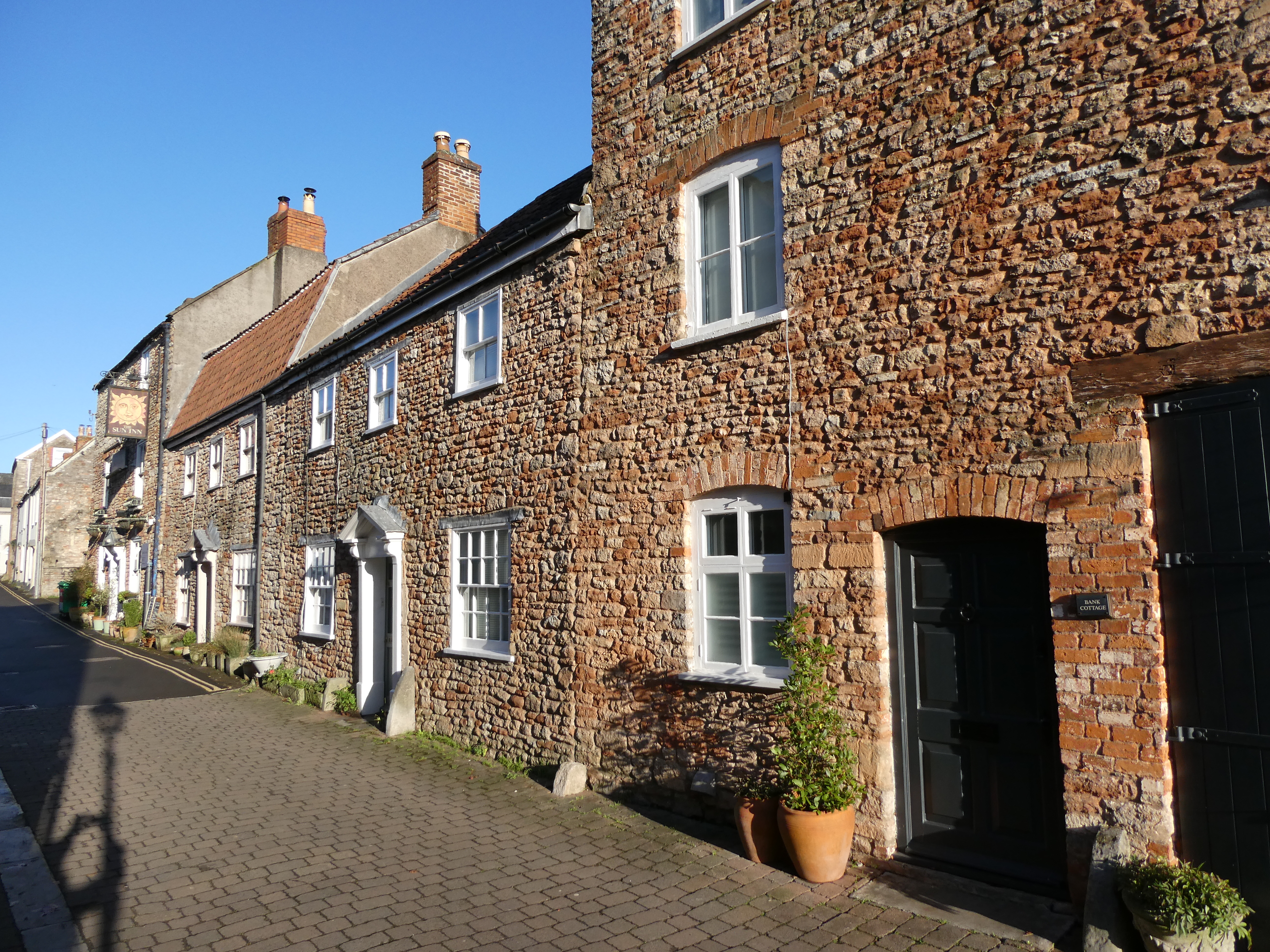













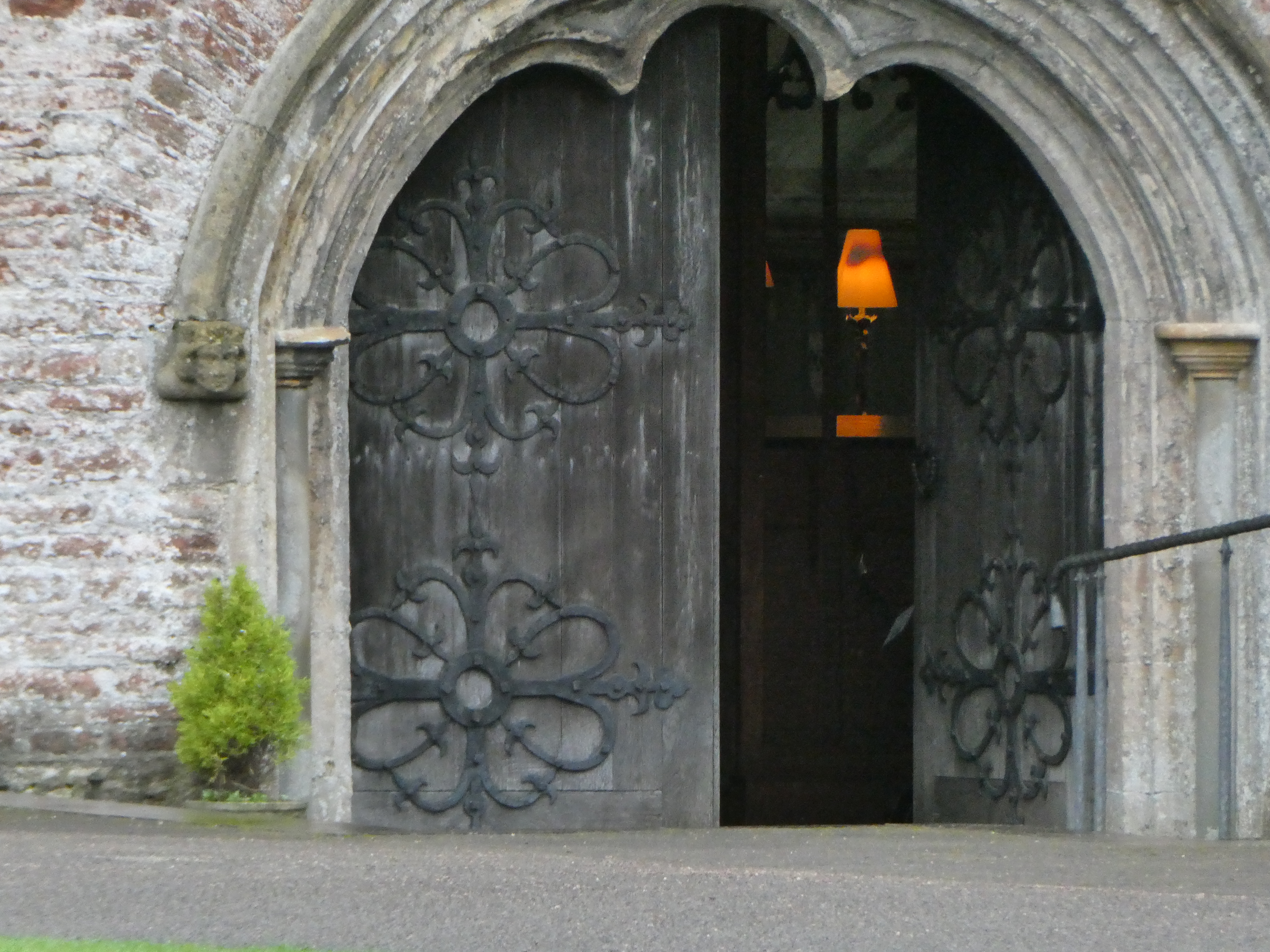
Panasonic Lumix TZ99 / ZS99: Video
Naturally, video has become as important as stills to many users of pocket cameras. The TZ99 / SZ99 obliges with 4K UHD recording at 30fps or 25fps. Set your sights a little lower for resolution with Full HD capture and the maximum frame rates increase to 60fps or 50fps. High-speed video is supported at 720p at up to 120fps or 100fps, or for 640x480 pixels at 240fps or 200fps.
Panasonic Lumix TZ99 / ZS99: Lab results
We don't usually lab test traditional compact cameras like the TZ99, as their small sensors don't perform well, and often there's no option to shoot in RAW, which we require to ensure fair testing. Consequently we only have a limited selection of compact cameras with which to compare the TZ99, and most are not direct rivals.
The Canon PowerShot SX730 HS has since been replaced by the SX740 HS, which you can still buy, but which we haven't lab tested. The two cameras share the same sensor and lens though, so image quality should be very similar. Since the SX730 HS can't shoot in RAW, our lab results are obtained from JPEG images. This means its high ISO shots will have had noise reduction applied in camera, artificially boosting its signal-to-noise scores. JPEG image processing will also boost dynamic range scores.
The Canon PowerShot G7 X Mark II shows what's possible from a compact camera if you increase sensor size to 1-inch, but consequently sacrifice some zoom reach. It's now been replaced by the Mark III version, but we haven't lab tested that.
The Ricoh GR IIIx is a premium compact camera with a large APS-C sized sensor. It represents close to the pinnacle of what a compact camera can do in terms of image quality.
Resolution (line widths/picture height):
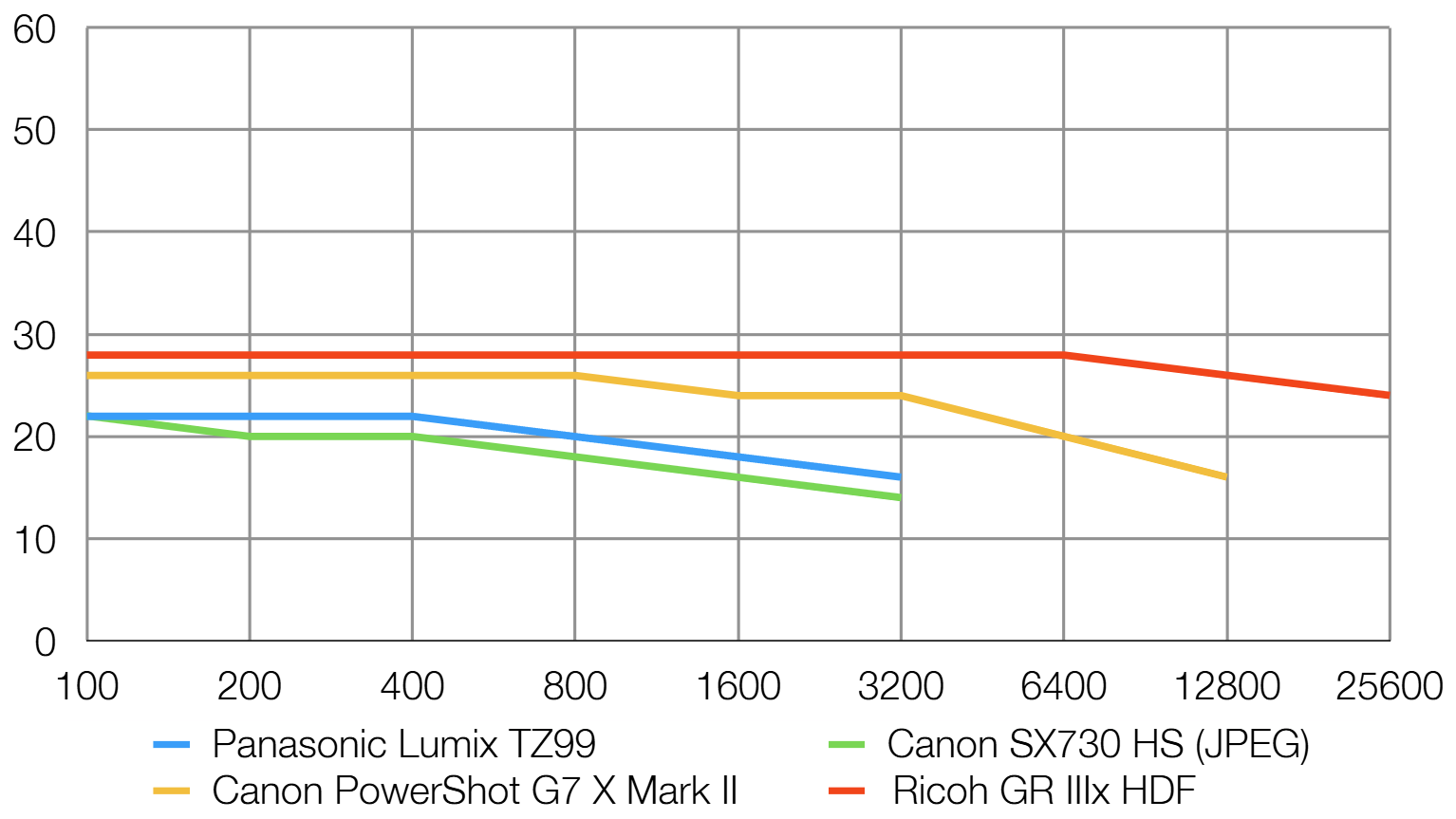
With such a small sensor, outright detail capture is never going to be the TZ99's forté, though with its ability to shoot in RAW, it does at least capture slightly more fine detail that the SX730 HS - a camera with the same sized sensor. Stepping up to a 1-inch-type or APS-C sensor inevitably makes a huge difference to resolving power.
Dynamic range (EV):
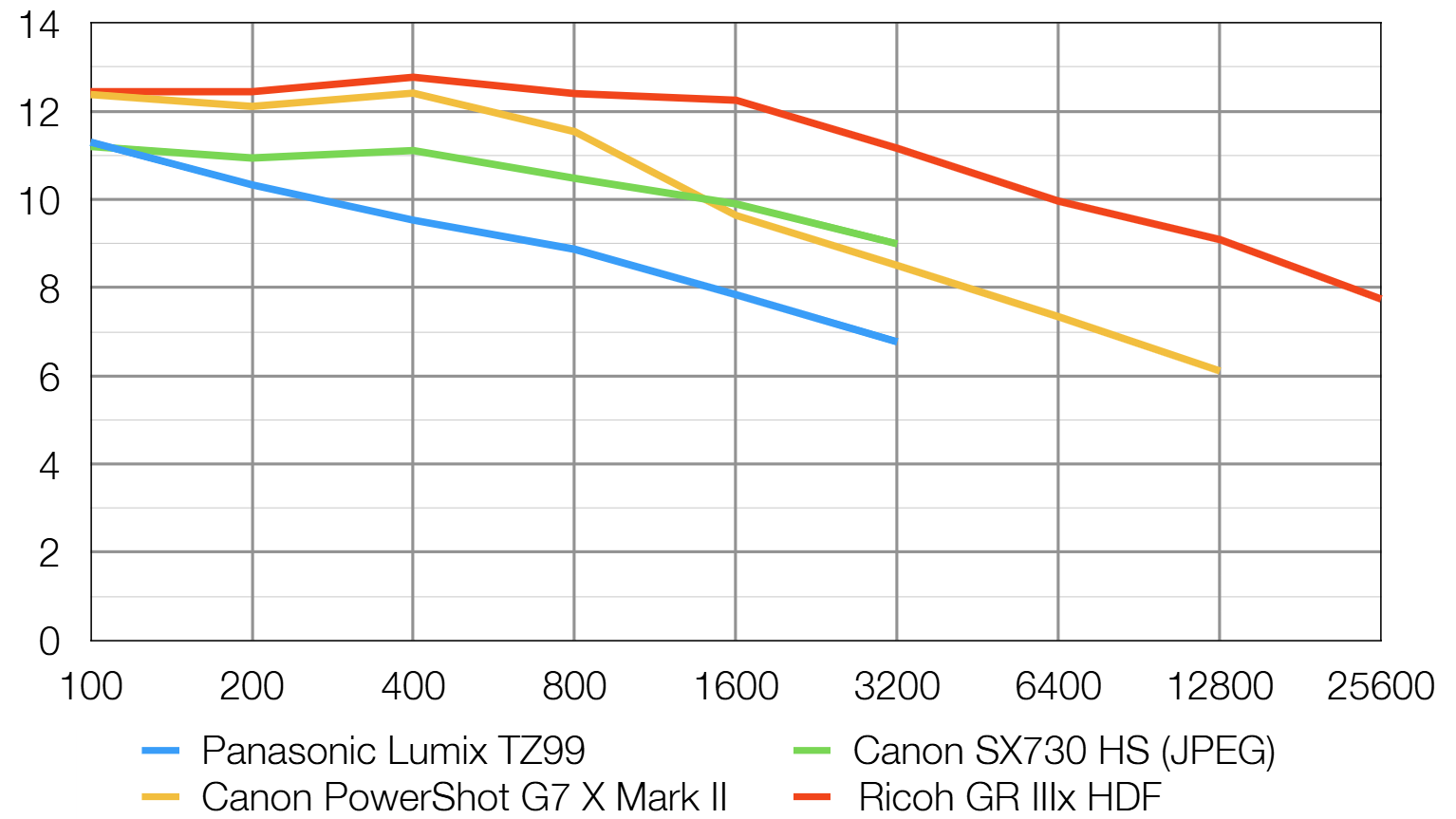
Dynamic range is a measure of a camera's ability to record extreme brightness ranges and still retain detail in the brightest and darkest parts of the scene. It's measured in EV (exposure values, or 'stops').
The TZ99 doesn't do very well in our dynamic range test, showing the limitations of its small sensor. The SX730 HS does better, but only because we have to use JPEGs, which have been enhanced by in-camera processing.
Signal to noise ratio (decibels):
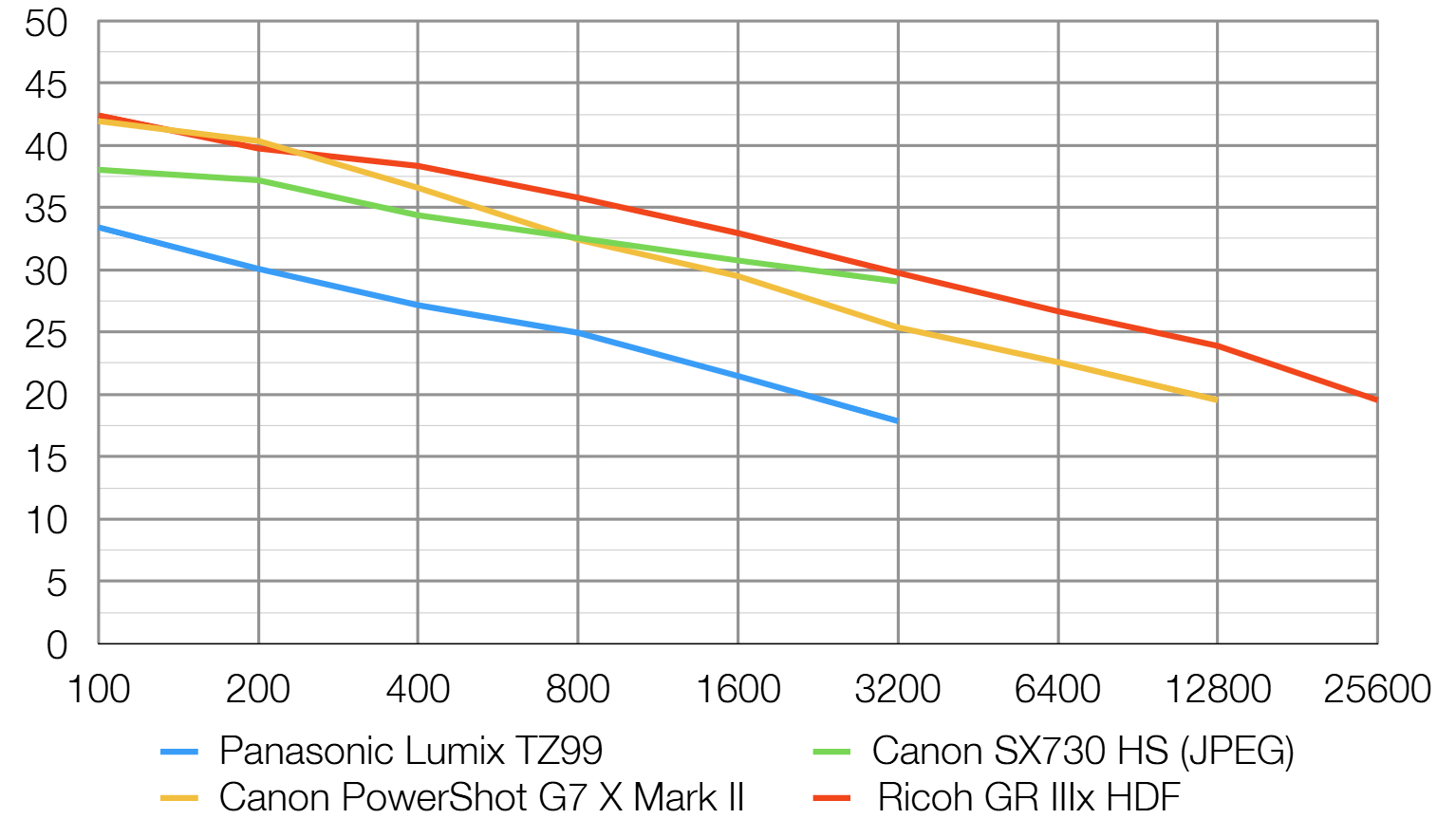
This test compares the amount of random noise generated by the camera at different ISO settings as a proportion of the actual image information (the 'signal'). Higher values are better and we expect to see the signal to ratio fall as the ISO is increased.
Again, it's not a great performance from the TZ99, though we'd expect comparable results from the SX 730 HS if that had the option to shoot in RAW like the Panasonic. The G7 X Mark II and Ricoh show what's possible with a larger sensor.
Panasonic Lumix TZ99 / ZS99: Verdict
It comes to something when the biggest new feature in an updated and upgraded camera is the loss of its viewfinder. Some might find that a deal-breaker in itself, especially those who don’t enjoy trying to compose images with bright sunlight bouncing off a camera’s rear screen. To be fair though, I think you could say that the loss of the viewfinder is quite a logical progression, at least for a point-and-shoot camera that competes with mobile phones. I like that the TZ99 / SZ99 has an updated USB-C port for data transfer and battery charging.
I think it’s a fun camera to use, I like that it’s small enough to slip into a pocket, and I enjoy its quality for both stills and video, at least under good lighting conditions. However, the camera suffers from poor dynamic range, a loss of fine detail, and image noise under low lighting.
All in all, I still prefer the bigger image sensor of my old (and now obsolete) TZ100, and feel that the penalty of a more restrictive zoom range is well worth the enhancement in image quality. But then again, the mighty zoom range is what helps the TZ99 / SZ99 sell itself as a worthy addition to the mobile phone that’s already in your pocket.
Features | The 30x optical zoom range and a tilting screen with front-facing flip lead the features list. | ★★★★☆ |
Design | It’s a neat and stylish camera with a fully retracting lens that handles well and is eminently pocketable. | ★★★★☆ |
Performance | Image quality is pretty respectable under good lighting conditions but drops off under challenging lighting. | ★★★☆☆ |
Value | It’s reasonably priced for what it is but not exactly great value for money. | ★★★☆☆ |
Should you buy the Panasonic Lumix TZ99 / ZS99?
✅ Buy this...
- You want a pocket-sized camera with a huge 30x optical zoom range that offers excellent telephoto reach.
- You’re after a fun point-and-shoot camera for travel and holiday snaps, with a flip screen for selfies and vlogging.
🚫 Don't buy this...
- You need good image quality for indoor shots and low-lit exteriors, with better fine detail and less image noise.
- You’d rather have a camera with a physically larger image sensor and don’t mind sacrificing some zoom range in the process.
Alternatives
The Canon PowerShot SX740 HS a neat point-and-shoot camera with a huge 40x optical zoom. It features a 20.3MP 1/2.3-inch image sensor, similar to that of the Panasonic camera, and costs around $480/£430.
The Sony Cyber-shot DSC-RX100 VII has a larger-format 1-inch image sensor, delivering 20.1 megapixels, and boasts a 24-200mm zoom lens. It costs around $1298/$£1049.
Matthew Richards is a photographer and journalist who has spent years using and reviewing all manner of photo gear. He is Digital Camera World's principal lens reviewer – and has tested more primes and zooms than most people have had hot dinners!
His expertise with equipment doesn’t end there, though. He is also an encyclopedia when it comes to all manner of cameras, camera holsters and bags, flashguns, tripods and heads, printers, papers and inks, and just about anything imaging-related.
In an earlier life he was a broadcast engineer at the BBC, as well as a former editor of PC Guide.
